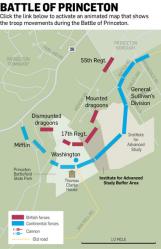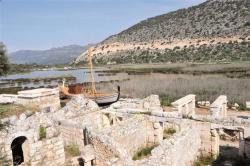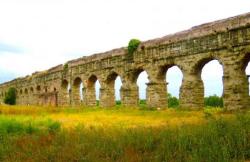INSTITUT SUPERIEUR D'ANTHROPOLOGIE
INSTITUTE OF ANTHROPOLOGY
ONLINE COURSES / COURS A DISTANCE
FALL TERM : OCTOBER 2015
REGISTER NOW
USA –  Princeton - A third archaeological survey of land where the Institute for Advanced Study plans to build faculty housing uncovered 10 artifacts relating to the Battle of Princeton, officials said Tuesday.Of 663 artifacts collected from the 7-acre tract, five musket balls and five pieces of grapeshot relating to the Battle of Princeton were identified, according to the firm's preliminary findings, detailed in an interim report. "These studies only represent a starting point towards developing the archeological research potential of the Princeton Battlefield," the report said.
Princeton - A third archaeological survey of land where the Institute for Advanced Study plans to build faculty housing uncovered 10 artifacts relating to the Battle of Princeton, officials said Tuesday.Of 663 artifacts collected from the 7-acre tract, five musket balls and five pieces of grapeshot relating to the Battle of Princeton were identified, according to the firm's preliminary findings, detailed in an interim report. "These studies only represent a starting point towards developing the archeological research potential of the Princeton Battlefield," the report said.
http://www.nj.com/mercer/index.ssf/2015/06/archaeological_survey_by_institute_for_advanced_st.html
TURQUIE –  Andriake - In the southern province of Antalya, one of the most important cities of the Lycian Union, the ancient city of Andriake, has been partially opened to visits. Andriake was the harbor of another ancient city of Myra and is located in what is now the Demre district of Antalya. Work was first started in the ancient city by the Akdeniz University Department of Classical Archaeology Professor Nevzat Çevik in 2009. Excavations were carried out in the plakoma (trade areas), harbor structures, city bath, eastern and western monuments, synagogues and churches of the city. By the end of four-year excavation and restoration, the ancient city was redesigned as a museum by the Culture and Tourism Ministry. The Roman-era Hadrian granary (grain storage), which was built in 129 A.D., was turned into the Museum of Lycian Civilizations. The granary has seven rooms and measures 56 meters long and 32 meters wide. Artifacts found during the excavations in the Lycian Union were placed in the museum. The structures in the Harbor Bazaar as well as the agora, synagogue and a six-meter deep, 24-meter long and 12-meter wide cistern were restored. A 16-meter long Roman-era boat, a crane and a cargo car were placed in front of the museum. Archaeology teams have always worked in the eastern part of the ancient city while the western part was previously unreachable due to its remote location, surrounded by trees and bush. It was finally unearthed and excavated at the end of 2013. The 30-day excavation unearthed the never-before-seen part of the ancient city. By the end of the excavation, arched structures, a church and city walls from the Roman and Byzantine period were found.
Andriake - In the southern province of Antalya, one of the most important cities of the Lycian Union, the ancient city of Andriake, has been partially opened to visits. Andriake was the harbor of another ancient city of Myra and is located in what is now the Demre district of Antalya. Work was first started in the ancient city by the Akdeniz University Department of Classical Archaeology Professor Nevzat Çevik in 2009. Excavations were carried out in the plakoma (trade areas), harbor structures, city bath, eastern and western monuments, synagogues and churches of the city. By the end of four-year excavation and restoration, the ancient city was redesigned as a museum by the Culture and Tourism Ministry. The Roman-era Hadrian granary (grain storage), which was built in 129 A.D., was turned into the Museum of Lycian Civilizations. The granary has seven rooms and measures 56 meters long and 32 meters wide. Artifacts found during the excavations in the Lycian Union were placed in the museum. The structures in the Harbor Bazaar as well as the agora, synagogue and a six-meter deep, 24-meter long and 12-meter wide cistern were restored. A 16-meter long Roman-era boat, a crane and a cargo car were placed in front of the museum. Archaeology teams have always worked in the eastern part of the ancient city while the western part was previously unreachable due to its remote location, surrounded by trees and bush. It was finally unearthed and excavated at the end of 2013. The 30-day excavation unearthed the never-before-seen part of the ancient city. By the end of the excavation, arched structures, a church and city walls from the Roman and Byzantine period were found.
http://www.hurriyetdailynews.com/andriake-opens-partially-to-visits-.aspx?pageID=238&nID=83721&NewsCatID=375
ITALIE –  Rome - For hundreds of years, the Anio Novus aqueduct carried water 87 km (54 miles) from the Aniene River of the Apennine Mountains down into Rome. Built between AD 38 and 52, scholars continue to struggle to determine how much water the Anio Novus supplied to the Eternal City -- until now. By studying limestone deposits that formed from the flowing water within the aqueduct, called travertine, University of Illinois at Urbana-Champaign researchers reported in the Journal of Archaeological Science an actual estimate for the aqueduct's flow rate of 1.4 m3/s (± 0.4). 'At this rate, the aqueduct would have supplied the city with 370 gallons of water each second,' said lead author Bruce Fouke, a professor of geology and microbiology and a member of the Carl R. Woese Institute for Genomic Biology at Illinois. 'That's enough water, per second, to take a three-hour shower or to take 7 baths.' This buildup of travertine within the aqueduct channel indicates the average water level, called the wetted perimeter. According to the wetted perimeter near Roma Vecchia, where the ancient Anio Novus aqueduct and travertine are well preserved, the aqueduct was almost always full of water. Still, their estimate is significantly lower than previous estimates, which did not account for the travertine. They found that even a small amount of travertine deposit served to significantly reduce the water flow by 25 percent. Former estimates have tried to reconcile flow rates recorded in AD 97 by Rome's water commissioner Sextus Julius Frontinus in his classic text entitled De Aquis. 'We believe his data should not be used, considering he did not have the means to accurately measure water flux and flow velocity,' Fouke said. 'Furthermore, Frontinus' data contained many discrepancies, which he blamed on measurement error, water theft and fraud in his water department.' Other recent estimates have used an average velocity. However, this new study found differences in slope across the aqueduct that could have caused velocity to vary by more than 1 m/s in some places. In turn, this would dramatically change estimates of the volume of water being transported. 'Regardless of the different estimates, researchers agree that these aqueducts were the core piece of infrastructure that permitted the large-scale urbanization,' Fouke said. 'With this reliable water supply, Rome's population was able to grow between 600,000 to a million people during the first century AD.'
Rome - For hundreds of years, the Anio Novus aqueduct carried water 87 km (54 miles) from the Aniene River of the Apennine Mountains down into Rome. Built between AD 38 and 52, scholars continue to struggle to determine how much water the Anio Novus supplied to the Eternal City -- until now. By studying limestone deposits that formed from the flowing water within the aqueduct, called travertine, University of Illinois at Urbana-Champaign researchers reported in the Journal of Archaeological Science an actual estimate for the aqueduct's flow rate of 1.4 m3/s (± 0.4). 'At this rate, the aqueduct would have supplied the city with 370 gallons of water each second,' said lead author Bruce Fouke, a professor of geology and microbiology and a member of the Carl R. Woese Institute for Genomic Biology at Illinois. 'That's enough water, per second, to take a three-hour shower or to take 7 baths.' This buildup of travertine within the aqueduct channel indicates the average water level, called the wetted perimeter. According to the wetted perimeter near Roma Vecchia, where the ancient Anio Novus aqueduct and travertine are well preserved, the aqueduct was almost always full of water. Still, their estimate is significantly lower than previous estimates, which did not account for the travertine. They found that even a small amount of travertine deposit served to significantly reduce the water flow by 25 percent. Former estimates have tried to reconcile flow rates recorded in AD 97 by Rome's water commissioner Sextus Julius Frontinus in his classic text entitled De Aquis. 'We believe his data should not be used, considering he did not have the means to accurately measure water flux and flow velocity,' Fouke said. 'Furthermore, Frontinus' data contained many discrepancies, which he blamed on measurement error, water theft and fraud in his water department.' Other recent estimates have used an average velocity. However, this new study found differences in slope across the aqueduct that could have caused velocity to vary by more than 1 m/s in some places. In turn, this would dramatically change estimates of the volume of water being transported. 'Regardless of the different estimates, researchers agree that these aqueducts were the core piece of infrastructure that permitted the large-scale urbanization,' Fouke said. 'With this reliable water supply, Rome's population was able to grow between 600,000 to a million people during the first century AD.'
http://machineslikeus.com/news/roman-aqueduct-flow-rate-determined?